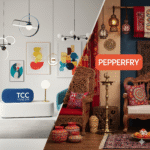Now Reading: Pepperfry’s Tech-Driven Strategy for Business Expansion
-
01
Pepperfry’s Tech-Driven Strategy for Business Expansion
Pepperfry’s Tech-Driven Strategy for Business Expansion

Pepperfry’s Journey: Transforming Homes with Technology and Innovation
Pepperfry, a name now synonymous with furniture and home essentials, marks its 11th year in the business. But did you know that it began its journey as a lifestyle brand, offering a range of products from jewelry and apparel to accessories? In a surprising twist, within a year, Pepperfry sensed a shift in customer preferences. The brand’s foray into furniture and home products had struck a chord, prompting them to pivot towards becoming a home and furniture giant by the end of 2012.
A Catalyst for Variety
The heart of Pepperfry’s strategy lies in its commitment to variety. Recognizing that shoppers once scoured multiple stores before making a purchase, Pepperfry embraced the marketplace model. This meant creating an online platform where Indian businesses could showcase their furniture and home goods, streamlining transactions for customers. This shift marked Pepperfry’s evolution into a managed marketplace, where the responsibility of ensuring a seamless transaction experience fell on their shoulders. This encompassed not only providing a platform for brands to sell but also offering shipping, warehousing services, and robust customer support.

Ashish Shah, Co-founder & COO of Pepperfry, shared that currently, around half of their business is driven by the marketplace, while the rest originates from their private labels or direct-to-consumer (D2C) brands. He also emphasized the pursuit of profitability as a significant milestone on their roadmap.
A Seamless Omnichannel Approach
Pepperfry recognized the blurred lines between online and offline shopping preferences. This insight led to the creation of India’s largest home and furniture omnichannel network. The brand’s journey into the physical realm began in 2014 with their first experience studio. Today, they boast over 210 studios across 125 cities. These spaces allow customers to interact with a selection of products physically. However, realizing that the entire collection couldn’t fit in a single store, Pepperfry cleverly blends the in-store and online experience. Customers can explore products in the studio and then seamlessly transition to the online catalog for a wider array of choices. This cohesive approach is a testament to their commitment to meeting customers at various touchpoints on their purchasing journey.
Driving Expansion through Innovation
Pepperfry’s expansion model hinges on franchising. Presently, out of their 210 stores, around 60 are company-owned and operated, while the remaining 150 operate as franchises. This approach has proven successful and is poised to drive further growth.
Diverse Array of Choices
With a staggering catalog of approximately 100,000 products, Pepperfry caters to diverse tastes. While furniture makes up a significant portion, non-furniture categories account for 50% of transactions. These smaller-ticket items might not dominate sales figures, but they inject vibrancy into the brand’s offerings. Ashish Shah shared their plans to enter the kitchen category, re-launching a complete kitchen catalog that includes appliances and essential products.
Elevating through Private Labels
Pepperfry’s unique edge comes from its seven private label brands – six in furniture and one in mattresses. Looking ahead, the brand aims to bolster their premium furniture private labels, particularly in sofas and loungers. These private labels contribute 50% of their revenue, showcasing a balanced coexistence with their marketplace business.
Tech as the Cornerstone
Technology is Pepperfry’s driving force, revolutionizing online furniture transactions. Their omnichannel approach seamlessly integrates online and offline experiences. Augmented Reality (AR) adds an interactive layer to their catalog, enabling customers to explore products from various angles and even visualize them in their living spaces. Looking forward, Pepperfry is investing in Virtual Reality (VR) technology, envisioning a future where customers can use devices like Google Glass to examine 3D furniture models. This tech infusion extends to retail spaces, enabling compact showrooms with the power of AR and VR.
Fostering a Community
In the past 18 months, Pepperfry has cultivated a community of designers and influencers through their ‘Pep Homies’ program. With over 2,000 community members, this initiative facilitates conversations about the brand, products, and the evolving landscape of home and furniture.
A Thriving Market in Tier II & III Cities
Pepperfry’s recent expansion has made deep inroads into Tier II and III cities. Notably, they’ve established a presence in Bihar, Orissa, and Kerala, as well as in regions like the Northeast. These markets contribute around 35% of their total business, and their growth potential remains substantial.

In closing, Pepperfry’s journey from a diverse lifestyle brand to a dominant furniture and home essentials platform exemplifies the power of adaptation and innovation. Driven by technology, committed to variety, and propelled by customer-centric strategies, Pepperfry continues to shape the way India decorates its homes.







